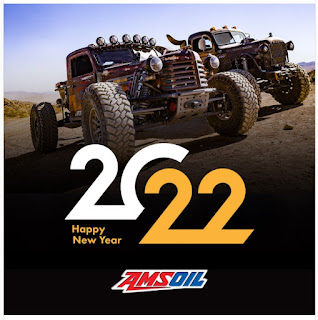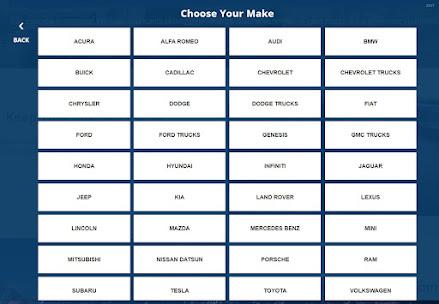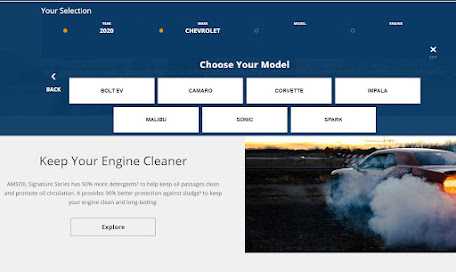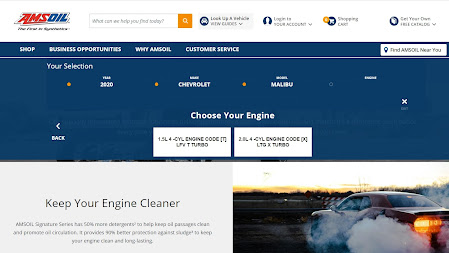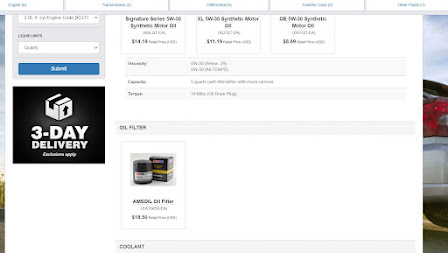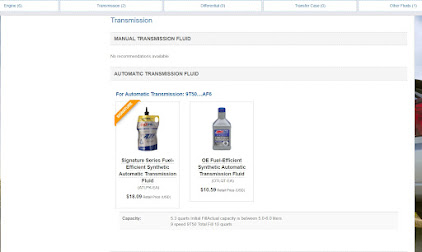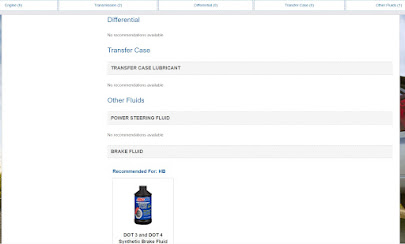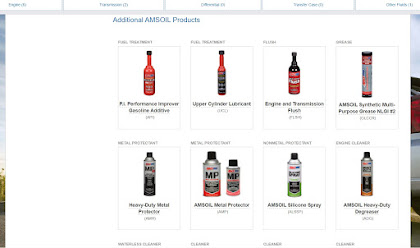This blog is dedicated to information to improve Performance and MPG (miles per gallon) as well as the latest news in the Automotive and Transportation industries.
Sunday, November 16, 2025
Wednesday, June 18, 2025
How the Positive Crankcase Ventilation (PCV) Valve Works In Your Car
A positive crankcase ventilation system routes pressurized crankcase gases back to the intake manifold to be burned during combustion. All those unburned gases flowing through the PCV valve, however, can create deposits and cause it to stick, which can increase oil consumption and even reduce fuel economy.
Using high-quality oil is essential to keeping your PCV valve working properly. Watch this video to learn more.
https://www.amsoil.com/?zo=278060
#TechTip l #TechTipTuesday l #Crankcase l #IntakeManifold #PCVValve
Wednesday, May 22, 2024
Tuesday, January 31, 2023
GM* recently launched a new motor oil performance standard with its proprietary dexos R* motor oil specification.
GM* recently launched a new motor oil performance standard with its proprietary dexos R* motor oil specification.
Testing is complete and AMSOIL Signature Series already outperforms the dexos R specification.
Read More:
https://blog.amsoil.com/gm-dexos-r-raises-the-motor-oil-bar-for-high-performance-engines/?zo=278060
 |
| General Motors new Dexos R Motoroil Specification |
#dexosr #gmdexos, #amsoil #amsoilsynthetics #amsoilwebsite #amsoilstore
Monday, January 03, 2022
Saturday, January 01, 2022
Happy New Year 2022 From Art & Inee AMSOIL Direct Jobbers!
Wednesday, November 10, 2021
AMSOIL Signature Series Synthetic Motor Oil Outperforms The Competition
Monday, August 23, 2021
Don't Put The Wrong Products In Your Car Or Truck!
Without a owner's manual handy, you can be sure to pick the correct products for your car or truck to satisfy the warranty or service you put it through. Here's the easiest way.
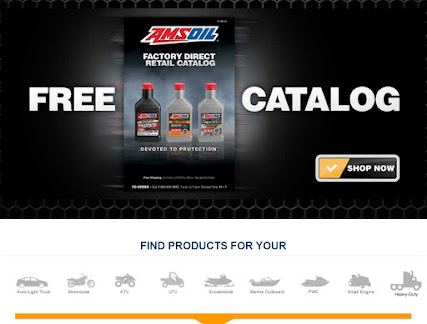 |
| How to access the Product Lookup Guides |
Then click on the category which best suits your application. In this case we are clicking "Auto/Light Truck".
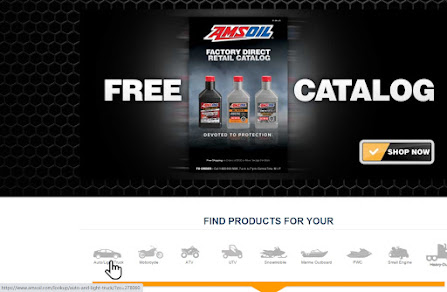 |
| Selecting the correct category for your products |
Now we need to select the correct year model of your vehicle.
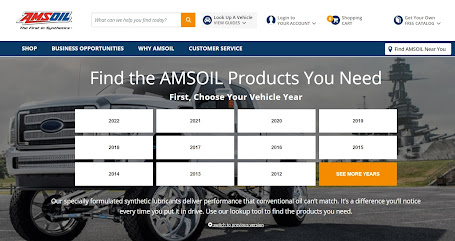 |
| Select your vehicle's year model |
Now we select the manufacturer of your vehicle. In this example we select "Chevrolet."
 |
| The correct coolant to use in this engine displayed. |
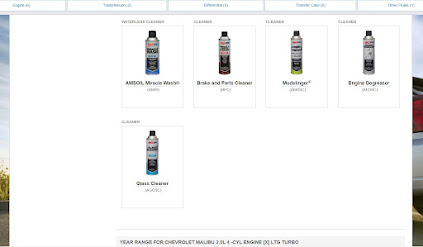 |
| Other products such as waterless car wash and glass cleaner. |
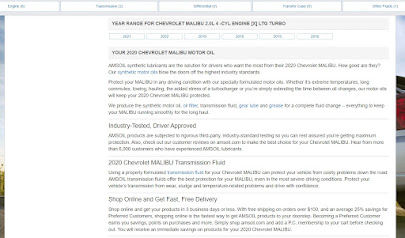 |
| Other details and information about your vehicle. |
Friday, January 17, 2020
The Need To Do Regular Oil Changes
Why Do I Need To Change My Oil?
Dan McClellandDan McClelland | Jan 07, 2020 8:36 AMRegardless of its quality, every motor oil eventually loses its potency and must be changed to ensure peak engine protection. Let’s take a look at what happens to motor oil over time and why you periodically need to change oil.
Losing the base
Base oils are the backbone of the finished lubricant that ends up in your engine. Over time, they lose effectiveness due to the following factors:Oxidation
The interaction between oxygen molecules and motor oil molecules naturally leads to chemical breakdown.Just as oxygen causes a cut apple to brown or exposed metal to rust, it breaks down base oils and reduces motor oil’s effectiveness.
Oxidation can lead to increased oil viscosity, which negatively affects energy efficiency. It also causes the formation of harmful deposits and sludge.
High heat
Today’s engines run hotter than ever before, with temperatures up to 235°F (113ºC), and even higher if towing or hauling.The rate of oxidation for oil doubles for every 18°F (10°C) increase in temperature.
Moisture
Your vehicle is subjected to temperature swings, even when it is parked in the garage.Those temperature swings cause condensation to form inside your engine, leading to water contamination.
Leaving a vehicle parked for extended periods or taking short trips that don’t allow the engine to fully warm up allow water to remain in the oil rather than evaporating and exiting through the tailpipe. Water can lead to formation of sludge…yet another reason why you must change oil.
Viscosity is a motor oil’s most important property. The lower the viscosity, the faster the oils flows, like water. Thicker oils flow more slowly, like honey.
Viscosity loss
A lubricant’s viscosity is its most important property.Viscosity has a direct bearing on wear protection, and your engine is designed to operate best using a motor oil of a specific viscosity (e.g. 5W-30).
The intense pressure the oil bears as it’s squeezed between moving parts, like the piston ring/cylinder wall interface, can tear apart, or shear, its molecular structure, leading to viscosity loss.
Suddenly, the 5W-30 motor oil your engine was designed to use is now essentially a 5W-20 oil, and wear protection may be compromised. When this happens, it’s time to change your oil.
Fuel dilution
Fuel can wash past the piston rings and contaminate the motor oil, causing it to lose viscosity.Frequent short trips that don’t allow the oil to reach normal operating temperature can be especially problematic because the fuel won’t volatilize and exit through the PCV system.
Excessive fuel dilution leads to sludge and varnish, requiring you to change oil more frequently.
Additives: designed to deplete
Additives are added to base oils to reduce destructive processes and enhance beneficial properties.For example, antioxidant additives help slow the rate of oxidation. Detergency additives help prevent deposits and sludge while cleaning pre-existing deposits. Formulators add anti-wear additives to some lubricants to form a sacrificial barrier on metal components and help prevent wear.
Since they’re sacrificial in nature, additive depletion is one of the primary reasons motor oil loses its effectiveness and must be changed.
While AMSOIL synthetic motor oil gives you the convenience of fitting oil changes into your schedule, it remains vital to install fresh oil at the appropriate time.Tuesday, March 03, 2015
Premium Protection For High-Horsepower Chrysler & Nissan Applications
New synthetic 0W-40 motor oil rounds out the Signature Series line.
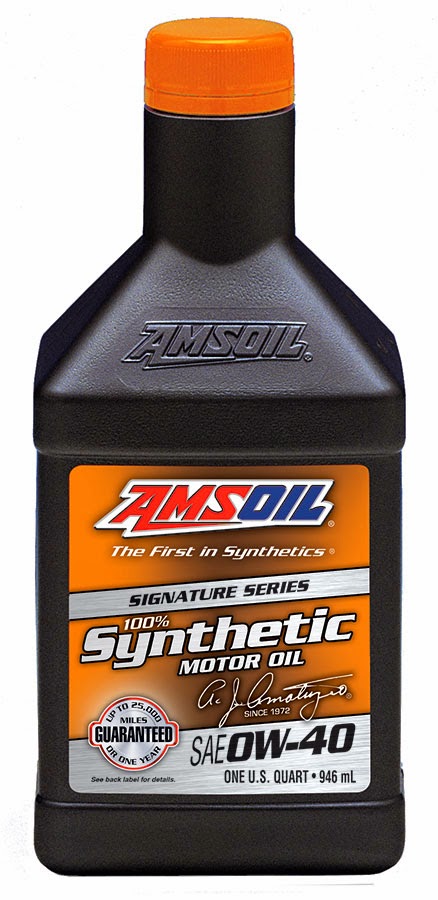 |
| AMSOIL Synthetic 0W-40 |
650 lb-ft of torque.
Powerful muscle car and big truck engines need a high-performance lubricant, and much like these powerful vehicles, AMSOIL sets the bar high when it comes to performance. AMSOIL established all-new standards for motor oil quality and performance when it introduced the world’s first synthetic motor oil to meet American Petroleum Institute (API) service requirements in 1972, and it continues to produce the top-performing lubricants available on the market.
New Signature Series 0W-40 Synthetic Motor Oil
Along with the new 5W-50 viscosity formulated for high-horsepower Ford Mustang engines, the Signature Series line now includes a robust 0W-40 synthetic motor oil formulated specifically for high-horsepower Chrysler and Nissan engines. AMSOIL Signature Series 0W-40 Synthetic Motor Oil (AZF) provides top-of-the-mark protection and performance that customers expect from Signature Series.· Withstands the stress of high horsepower and heat to provide outstanding wear protection
· Resists viscosity loss due to mechanical shear
· Resists thermal breakdown
· Helps prevent sludge deposits and keeps engines clean
· Reduces oil consumption and emissions
· Maximizes fuel economy
Applications
Signature Series 0W-40 is recommended for Chrysler and Nissan applications calling for a 0W-40 viscosity and requiring the following performance specifications:· API SN, SM...
· Chrysler MS-12633, MS-10725, MS-10850
· Nissan GT-R®
Applications include, but are not limited to, the following:
· Dodge Charger 6.1L/6.4L
· Dodge Challenger 6.1L/6.4L
· Dodge Viper 8.3L/8.4L
· Dodge Ram 2500/3500/4400/5500 6.4 L
· Chrysler 300 6.1L/6.4L
· Jeep SRT Grand Cherokee 6.1L/6.4L
· Nissan GT-R 3.8L
More information on AMSOIL Synthetic 0W-40 Motor Oil
Thursday, February 26, 2015
Lubrication Technology Explained
LUBRICATION 101: A LOOK AT BASIC LUBRICATION CONCEPTS
Lubrication can be a daunting subject for someone unfamiliar with its basic concepts. Even someone with experience in the field can be confused by the multitude of lubricants available on the market today. Reviewing a few basic lubrication principles can make it easier to understand why proper lubrication is necessary in every application.FRICTION
Webster defines friction as the “rubbing of one body against another,” and as “resistance to relative motion between two bodies in contact.” Friction can be beneficial. It generates heat that can be used to start a fire, and it is the principle behind a vehicle’s braking system.Friction can also be detrimental. The heat generated as the result of friction can cause damage to an engine. Because contact is required to generate friction, wear can take place in these areas of contact, leading to material failures, overheating and the formation of deposits. Although there are many ways to reduce friction, the most common way is through the use of a fluid or semifluid lubricant. The key characteristic of lubricants is that they are not readily compressible, minimizing component contact or eliminating contact altogether.
TYPES OF LUBRICATION
There are three types of lubrication conditions that can exist between two surfaces:Hydrodynamic or Full-Film Lubrication is the condition in which surfaces are completely separated by a continuous film of lubricating fluid. The non-compressible nature of this film separates the surfaces and prevents metal-to-metal contact. The lubricant’s viscosity assumes responsibility for the majority of wear protection; additives play a limited role. Although full-film lubrication does not generally allow metal-to-metal contact, abrasive wear or scratching can still occur if dirt particles penetrate the lubricating film.
HYDRODYNAMIC LUBRICATION
BOUNDARY LUBRICATION
OTHER LUBRICANT FUNCTIONS
COMPONENTS OF A LUBRICANT
INCREASED DEMAND ON LUBRICANTS
HOW ARE SYNTHETIC OILS DIFFERENT?
Friday, January 09, 2015
Premium Protection for High-Horsepower Ford Mustangs
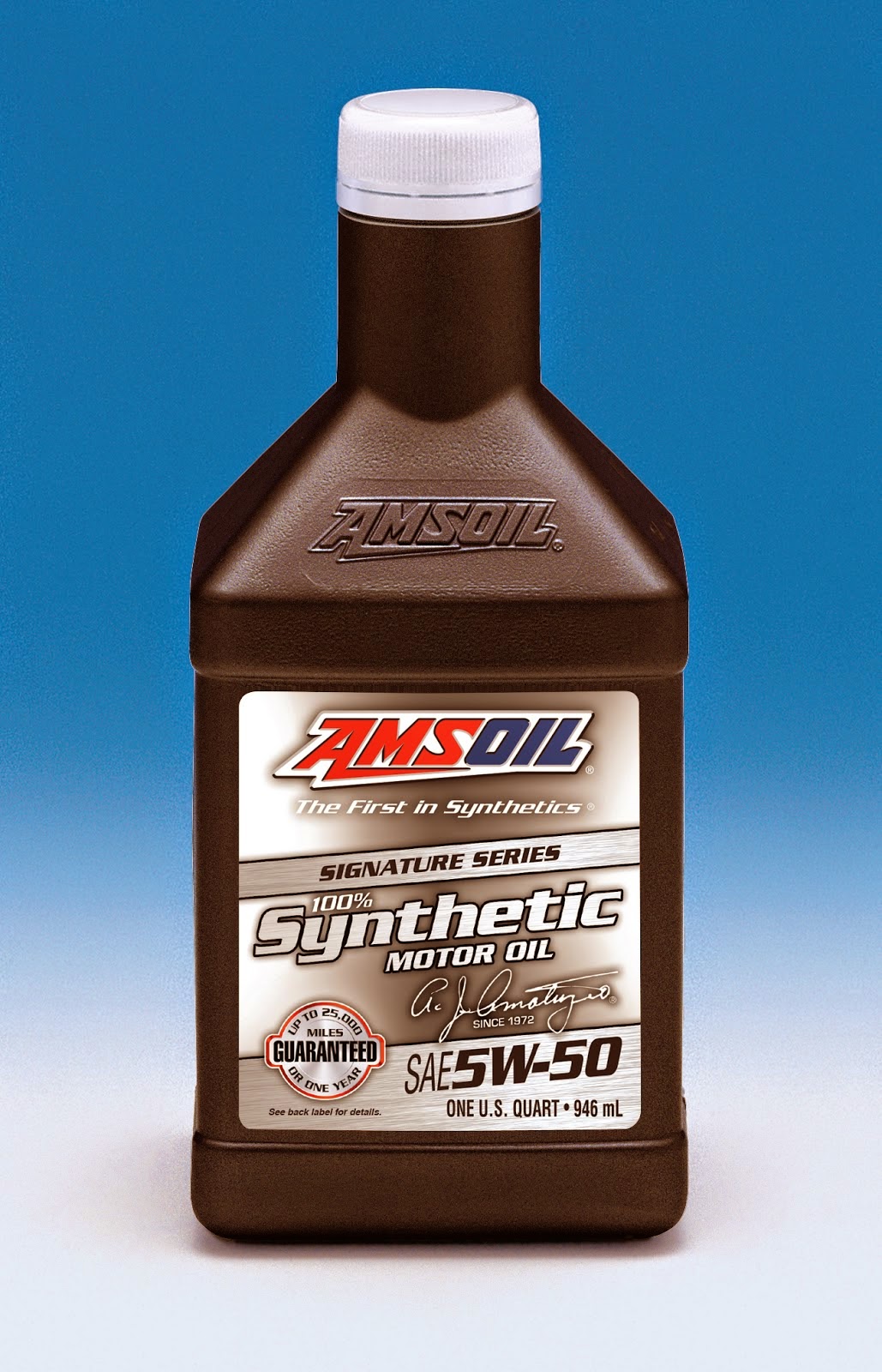 |
| 5W-50 Synthetic Motor Oil |
AMSOIL has expanded the Signature Series line to include a robust 5W-50 synthetic motor oil formulated specifically for high-horsepower Ford Mustang engines. Signature Series 5W-50 Synthetic Motor Oil (AMR) provides top-of-the-mark protection and performance that customers expect from Signature Series, and it is excellent for all Mustang engines calling for a 5W-50 viscosity.
For more information:
AMSOIL Signature Series 5W-50 Synthetic Motor Oil for High-Horsepower Ford Mustangs
Tuesday, January 28, 2014
Solving the Challenges of Flat-Tappet Cams in Classic Car Engines
Summer belongs to classic cars and hot rods. It's the season when thousands visit car shows across North America and loyalists of every make and model cruise the streets to show off their rides. One of the big concerns among classic car owners in recent years, however, has been the abundance of flat-tappet camshaft failures that many attribute to the reduction of zinc and phosphorus in today's oil formulations.
Zinc dialkyldithiophosphate (ZDDP) is the most common zinc-based additive, and is used primarily as an anti-wear agent to prevent premature engine wear. It also provides corrosion and oxidation protection. However, because the zinc and phosphorus found in ZDDP can negatively affect catalytic converters, it has been phased out of motor oil formulations in recent years.Reducing ZDDP content has drawbacks, as classic car owners have found. Older vehicles with flat tappet camshafts and, in particular, engines that include high-tension valve springs or other modifications that create high contact pressures can suffer premature wear due to reduced ZDDP levels.
Flat-Tappet vs. Roller Cams
The design of flat tappet cams makes them especially vulnerable to wear. As the name indicates, the tappet - or lifter - is flat. During operation, the surface of the cam lobe slides rapidly over the surface of the tappet, producing high friction and temperatures. A thin oil film is the only barrier that prevents the lifter and cam lobe from welding together. If the oil film fails or provides insufficient wear protection, the two components can eventually wear the flat tappet cam and affect valve operation. Engine power and efficiency can decline if the flat tappet cam cannot lift the valves enough to adequately charge the chamber for ignition or release exhaust fumes. Because most V8 engines of the muscle-car era came standard with flat tappet cams, the problem is especially prevalent to classic-car and hot-rod owners.Roller cams, on the other hand, are differentiated by rolling contact rather than sliding contact. Although more costly, roller cams are common in most modern vehicles and can be retrofitted into classic-car and hot-rod engines.
 |
| Click for larger image |
Demand for High-Zinc Oils
The abundance of flat tappet camshaft failures in classic-car and hot-rod circles has spurred the market for high zinc motor oils formulated especially to protect flat tappet cams AMSOIL Z-ROD® 20W-50 Synthetic Motor Oil (ZRT) and AMSOIL Z-ROD® 10W-30 Synthetic Motor Oil (ZRF) are specially engineered for these classic and high-performance vehicles. It features a high-zinc formulation to help prevent wear on flat tappet cams and other critical engine components. Because many of these vehicles sit idle much of the time, Z-ROD contains a proprietary blend of rust and corrosion inhibitors for added protection during longterm storage. Z-ROD Synthetic Motor Oil is designed to perform on the street and protect during storage.Complete Vehicle Protection
Classic cars and hot rods need more than just premium engine protection. Many are modified to deliver increased power and torque, placing added stress on the transmission, differential and chassis. AMSOIL Synthetic Manual Transmission & Transaxle Gear Lube (MTG), Severe Gear® Synthetic Gear Lube (SVG, SVT, SVO & Dominator® Synthetic Racing Grease (GRG) offer advanced protection modified classic cars and hot rods need. These and other products are featured in the new Classic Cars Brochure (G3113).Purchase AMSOIL products at up to 25% discounted as an AMSOIL Preferred Customer.
Monday, January 27, 2014
AMSOIL Signature Series Synthetic Motor Oil Outperforms Competition in New Study
Nine synthetic motor oils were compared to AMSOIL Signature Series 5W-30 Synthetic Motor Oil (ASL). When it was all said and done, Signature Series demonstrated the best overall performance and cost-effectiveness.
|
A Study of SAE 5W-30 Synthetic Motor Oils
Signature Series 5W-30 Synthetic Motor Oil and nine other synthetic oils were subjected to five industry tests conducted according to American Society of Testing and Materials (ASTM) methodology. The overall annual cost of each oil was also compared. The study included synthetic motor oils exclusively for a number of reasons. First, most motorists now understand that synthetics provide increased performance benefits compared to conventional oils, so convincing consumers of synthetics' superiority is less of an issue. Second, while conventional motor oil sales remain flat, demand for synthetics continues to increase. Third, testing only synthetics facilitates an apples to apples comparison.Methodology
Testing examined several important areas of motor oil performance, including resistance to deposit formation, wear protection, high-temperature stability, resistance to acid formation and cold temperature performance.Each oil was subjected to the following ASTM test methodologies:
- Thermo-Oxidation Engine Oil Simulation Test (TEOST, ASTM D 6335)
- NOACK Volatility Test (ASTM D 5800)
- Four-Ball Wear Test (ASTM D 4172 Mod.)
- Total Base Number (ASTM D 2896)
- Cold Cranking Viscosity (ASTM D 5293)
Candidate Oils
The following nine oils were selected for the study:- Castrol Edge® with Titanium Fluid Strength Technology®
- Lucas Synthetic
- Mobil 1™ Extended Performance
- Pennzoil Ultra™
- Petro-Canada SUPREME Synthetic™
- Quaker State Ultimate Durability™
- Red Line High Performance Motor Oil
- Royal Purple High Performance Motor Oil
- Valvoline SynPower® Full Synthetic Motor Oil
Results
AMSOIL Signature Series Synthetic Motor Oil displayed the best results in the Four-Ball Wear, Total Base Number and Cold Crank Viscosity Tests. Results in the NOACK and TEOST Tests were also impressive, proving Signature Series Synthetic Motor Oil's excellent high-temperature performance. Other oils performed well in some tests, but not as well in others, illustrating the challenge inherent in formulating a high-quality motor oil that performs well in tests designed to assess optimum engine protection and life. In addition to delivering outstanding performance, Signature Series Synthetic Motor Oil provides maximum cost-effectiveness - even at retail pricing. Because they buy at wholesale, Dealers and Preferred Customers receive even more value. In the end, no other oil demonstrated itself capable of providing the overall performance in these tests and cost effectiveness of Signature Series. |
| Click for larger image |
 |
| Click for larger image |
AMSOIL 5W-30 Signature Series Synthetic Motor Oil
Wednesday, January 22, 2014
AMSOIL Synthetic Lubricants Proven in Las Vegas Taxi Fleet Field Trial
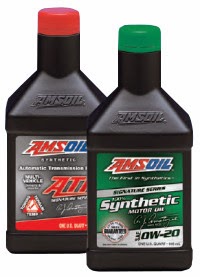 |
| Click for information at AMSOIL.com |
With modern vehicles producing increased heat, the ability of lubricants to protect against sludge and deposit formation is becoming more important. Motor oils and transmission fluids must demonstrate increased thermal stability throughout longer drain intervals for components to last as designed.
AMSOIL synthetic lubricants are formulated with reserve protection to withstand heat and its negative effects. To demonstrate it, AMSOIL Signature Series Synthetic Motor Oil and Signature Series Synthetic Automatic Transmission Fluid were put to the test in taxi cabs operating in the searing desert heat of Las Vegas, Nev.Taxi Fleet
Taxis are notoriously hard on lubricants due to excessive idling and constant stop and go driving loaded with passengers and cargo. Las Vegas summer temperatures added to the challenge, topping 100ºF during this field study.Six vehicles operated with AMSOIL synthetic lubricants for 18 months. The vehicle selected for further analysis – a 2010 Dodge Charger equipped with a 2.7L V6 engine and 4-speed automatic transmission – accumulated 7,033 hours (102,582 miles) prior to the engine and transmission disassembly. Given the unusually high amount of idle time, maintenance intervals were determined in hours rather than miles. Signature Series 0W-20 Synthetic Motor Oil (ASM), changed every 900 hours or approximately 15,000 miles, was used in the Charger’s engine, while the transmission used Signature Series Multi-Vehicle Synthetic Automatic Transmission Fluid (ATF), which was not changed during the study.
The Charger operated throughout Las Vegas up to 24 consecutive hours each day, with the engine shut down only during refueling and personnel changes. Average speed was 14.6 mph, while the EPA indicates the average speed for city driving is 21.2 mph, illustrating the excessive amount of idle time and stop and go driving.
Results
Transmission components prone to the effects of lubricant failure, including the valve body and clutch plates, revealed virtually no sludge and little wear after operating 7,033 hours (102,582 miles) on a single fluid change. Although the Charger carried a recommended transmission fluid change interval of 60,000 miles in severe service, Signature Series Multi-Vehicle Synthetic ATF continued providing superior protection well beyond the severe-service recommendation, confirming its ability to provide reserve protection.Engine components susceptible to the formation of harmful sludge, including the oil pan, oil pickup tube and cylinder heads, revealed virtually no sludge, earning high ratings from an independent calibrated rater. Results prove the ability of Signature Series Synthetic Motor Oil to safely extend drain intervals in severe service. Complete results are available in the Las Vegas Taxi Fleet Field Study (G3118) available from AMSOIL Inc.
 |
| Click for larger image |
head contained virtually no sludge, confirming the superior heat resistance of
Signature Series Synthetic Motor Oil and Signature Series Synthetic ATF.
 |
| Click for larger image |
Tuesday, January 14, 2014
Reading a Product Data Bulletin: Viscosity
 A lubricant's viscosity and how it changes under different temperatures and operating conditions is one of the most
important properties determining performance and protection. Accordingly, Kinematic viscosity is generally the first
property listed on an AMSOIL product data bulletin.
A lubricant's viscosity and how it changes under different temperatures and operating conditions is one of the most
important properties determining performance and protection. Accordingly, Kinematic viscosity is generally the first
property listed on an AMSOIL product data bulletin.Kinematic viscosity, measured using ASTM D 445 methodology, determines an SAE oil's hightemperature viscosity grade (for example, the "30" in 5W-30), while its Cold Crank Simulator (CCS) viscosity, measured using ASTM D 5293 methodology, determines its low-temperature grade (the "5W" in 5W-30).
Why Two Different Test Methods?
Viscosity can be viewed in two ways. Kinematic viscosity is defined by the lubricant's resistance to flow and shear due to gravity. To illustrate, imagine pouring two containers, one filled with water and the other with honey. The rate at which each fluid flows is governed by its Kinematic viscosity. Since the Kinematic viscosity of water is lower, it flows faster.Dynamic (or absolute) viscosity, measured by the CCS test, is defined as the lubricant's resistance to flow as indicated by its measured resistance, best thought of as the amount of energy required to move an object, such as a metal rod, through the fluid. It takes less energy to stir water compared to honey because the dynamic/ absolute viscosity of water is lower.
Each test method is designed to replicate a specific operating condition, allowing formulators and end-users to determine the lubricant's characteristics when in use. The CCS viscosity test evaluates the amount of energy it takes to start an engine at a specified cold temperature; the lower the viscosity grade, the lower the temperature at which the test is performed. The test assigns a value in centipoise (cP), used to determine the viscosity grade. Using Signature Series 5W- 30 as an example, its viscosity at -30ºC (-22ºF) can be no greater than 6600 cP to receive a 5W grade (see chart). Lower values reflect lighter-viscosity oils.
The Kinematic viscosity test attempts to simulate viscosity at normal operating conditions for a passenger car/light truck. The test is performed at 100ºC (212ºF) and/or 40ºC (104ºF), depending on the grading system being used. The value at
100ºC is used to determine the SAE viscosity grade. The test measures how long the oil takes to completely flow from a viscometer device heated to 100°C. The elapsed time in seconds is converted to centistokes (cSt). Lower values reflect lighter-viscosity oils.
Viscosity Index
The viscosity index (VI) of a lubricating fluid refers to how much the viscosity of the fluid changes due to temperature. A high VI indicates the fluid undergoes little viscosity change due to temperature fluctuations, while a low VI indicates a relatively large viscosity change. The Viscosity Index Test (ASTM D 2270) is based on the Kinematic viscosity of the fluid at 40°C (104°F) and 100°C (212°F). A fluid whose viscosity does not change much between these two temperatures will have a higher VI than a fluid whose viscosity change is greater. Viscosity index numbers above 95 are considered high. Fluids with a high VI provide more protection to critical components over a wide range of temperatures by maintaining fluid thickness and the necessary fluid barrier between parts.AMSOIL posts data information proudly on each product page at or near the bottom of the page. Check out the different AMSOIL Synthetic Motor Oils data information posted by clicking on a specific motoroil and opening the page. Compared to other motoroils on the market, AMSOIL is clearly superior. AMSOIL Synthetic Motor Oils
Monday, January 13, 2014
Oil Additives Can Offset the Careful Balance of a Well-Formulated Motor Oil
An overabundance of anti-wear agents, for example, can lead to reduced resistance to corrosion.
Dan Peterson - Vice President Technical Development AMSOIL Inc.
I don't get up on my soapbox very often – partly because I have put on a few extra pounds and don't want to break the box, and partly because it's just not my personality. Not a lot of things really get to me, but when I come across something that does, you don't want to be with me in the car for a long drive. One of these things is engine oil additives. The last time I stopped by the local parts store to pick up a tool for a brake job on my Ford Fusion, I stood in the aisle for a full 10 minutes looking at the huge display of engine oil additives. I was not in a hurry, so I picked up a dozen or so and read the marketing claims.Wow; it seems almost any internal engine problem in the world can be solved simply by using an engine oil additive. "Restores engine life, eliminates dry starts, eliminates engine noise, restores parts' surfaces AND compensates current wear!" Now I see why people buy all these oil additives. Too busy or just not interested in taking care of your vehicle? Just wait until you have a problem and then buy a solution at the local parts store and you are back in business. Our instant-gratification culture pushes us into believing in quick solutions. In reality, there are very few quick solutions that can correct years of neglect in any area of life, including your internal combustion engine. Very few, if any, engine oil additives solve engine issues overnight or somehow restore engines to their original condition. So how do you get the longest, trouble-free life out of your engine? Use a highquality, trusted brand of synthetic motor oil regularly and don't add any engine oil additives. Formulating a motor oil to perform all the critical jobs required by your engine is a balancing act. You can't just focus on improving one property without testing and evaluating the impact on all critical oil properties. Many times, use of additives improves one property, but causes other properties to take a nosedive.
Formulating synthetic motor oils is a core strength developed over the past 40 years at AMSOIL, and it is not an easy task. Motor oils need to protect engines against abnormal wear, excessive varnish, sludge, rust and corrosion and damaging foam. Motor oils also need to remove heat, help meet fuel economy standards, keep engine seals from leaking and keep catalytic converters working effectively over their projected lives.
Many negative outcomes derived from using engine oil additives have been documented over the years, including accelerated corrosion, excess oil thickening in cold temperatures and increased deposit formation. Most of these negative outcomes are relatively complicated chemical interactions, but just like your family is interconnected, so is the chemistry in your motor oil. When you add Uncle Buck to your family for a week, you and the kids all have a lot more fun staying up late and listening to stories, but he upsets the family balance. The kids have black circles under their eyes from staying up too late, you argue with your spouse about a few choice new words the kids picked up and you have to clean up cigar butts all over the garage when he finally leaves. Seems fun at first, but a week-long visit proves having Uncle Buck live with you for good isn't such a good idea.
The chemicals in motor oils are all interconnected and work together like a family unit to provide all the important properties required to keep your engine operating well. Most motor oils are designed with a measured amount of wear protection and deposit control. The problem comes when you add a whole bunch of extra or new wear protection or deposit control, and it ends up creating corrosion or destroying coldtemperature properties. Motor oils that perform well have some Uncle Buck built in, but at an appropriate level that does not upset critical chemistry in other areas designed to keep your engine running smoothly over the long run.
If you want a more detailed explanation by industry experts, a recent Noria announcement outlined that "Aftermarket oil additives can backfire." In the book, "Practical Handbook of Machinery Lubrication," the following description is listed:
"Increasing the percentage of a certain additive may improve one property of an oil while at the same time degrade another. When the specified concentrations of additives become unbalanced, overall oil quality can be affected. Some additives compete with each other for the same space on a metal surface. If a high concentration of an anti-wear agent is added to the oil, the corrosion inhibitor may become less effective. The result may be an increase in corrosion-related problems."
It's a much fancier way of saying too much of your Uncle Buck is not good for your marriage. Next time you talk to someone who is contemplating using one of those flashy new engine oil additives, tell them about the importance of maintaining the critical balance in motor oil and what can happen when it becomes unbalanced.
AMSOIL Synthetic Motor Oils
